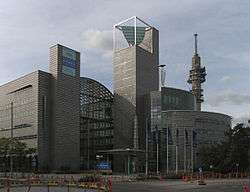Yle
Yleisradio Oy (Finnish), literally General Radio or General Broadcast; Swedish: Rundradion Ab; abbr. Yle ([yle]), is Finland's national public broadcasting company, founded in 1926. It is a joint-stock company which is 99.98% owned by the Finnish state, and employs around 3,200 people in Finland. Yle shares many of its organizational characteristics with its UK counterpart, the BBC, on which it was largely modelled.
 | |
| Type | Terrestrial radio, television and online |
|---|---|
| Country | |
| Availability | National International |
| Founded | 9 September 1926 (Radio) 1 January 1958 (Television) |
| Slogan | Oivalla jotain uutta English: Realize something new |
| 45.2% of Finnish television viewers and 53% of radio listeners (2010)[1][2] | |
| Headquarters | Helsinki, Finland |
| Owner | 99.9% state-owned, supervised by an Administrative Council appointed by Parliament |
| Parent | Ministry of Transport and Communications |
Key people | CEO Merja Ylä-Anttila |
Launch date | 9 September 1926 |
Former names | O.Y. Suomen Yleisradio - A.B. Finlands Rundradio[3] |
Official website | yle |

For the greater part of Yle's existence the company was funded by the revenues obtained from a broadcast receiving licence fee payable by the owners of radio sets (1927–1976) and television sets (1958–2012), as well as receiving a portion of the broadcasting licence fees payable by private television broadcasters. Since the beginning of 2013 the licence fee has been replaced by a public broadcasting tax (known as the Yle tax), which is collected annually from private individuals and corporations together with their other taxes.
By far the largest part of the Yle tax is collected from individual taxpayers, with payments being assessed on a sliding scale. Minors, as well as persons with an annual income of less than €7,813 are exempt. At the lower limit the tax payable by individuals amounts to €50 per annum and the maximum (payable by an individual with a yearly income of €20,588 or more) is set at €140.[4] The rationale for the abolition of the previous television licence fee was the development of other means of delivering Yle's services, such as the Internet, and the consequent impracticality of continuing to tie the fee to the ownership of a specific device. Yle receives no advertising revenues as all channels are advertisement-free.
Yle has a status that could be described as that of a non-departmental public body. It is governed by a parliamentary governing council. Yle's turnover in 2010 was €398.4 million. In 2018 Yle's annual budget was about €530 million .[5]
Yle operates four national television channels, 13 radio channels and services, and 25 regional radio stations. As Finland is constitutionally bilingual — around 5.5% of the population speaks Swedish as their mother-tongue — Yle provides radio and TV programming in Swedish through its Swedish-language department, Svenska Yle. As is customary in Finnish television and cinemas, foreign films and TV programmes, as well as segments of local programmes that feature foreign language dialogues (e.g. news interviews), are generally subtitled on Yle's channels. Dubbing is used in cartoons intended for young children who have not yet learned to read; off-screen narration in documentaries is also frequently dubbed.
In the field of international broadcasting, one of Yle's best known services was Nuntii Latini, the news in Latin, which was broadcast worldwide and made available over the Internet.
Yle was one of 23 founding broadcasting organisations of the European Broadcasting Union in 1950. Yle hosted the Eurovision Song Contest 2007 in Helsinki.
History
Suomen Yleisradio (Finland's General Radio) was founded in Helsinki on 29 May 1926. The first radio programme was transmitted on 9 September in that year, and this is the date generally considered to be the birthday of regular broadcasting activities in Finland. However, it was not until 1928 that Yle's broadcasts became available throughout the country. After this the broadcasting network was developed and by the beginning of the 1930s, 100,000 households were able to listen to Yle programmes.
In 1957, Yle made its first television broadcast tests, and the following year regular TV programming was started under the name Suomen Televisio (Finland's Television), which was later renamed Yle TV1. The popularity of television in the country grew rapidly. In 1964, Yle obtained TES-TV and Tamvisio, which were merged to Yle TV2. In 1969, the Finnish Broadcasting Company began broadcasting television programs in colour, but due to the high cost of technology, virtually all programs appeared in colour only in the late 1970s. On May 1, 1977, Tv-uutiset (~ TV-news) and TV-nytt switched to colour.
In the 2000s, Yle has founded a number of new radio and television channels. In 2007 there was a digital television switchover. A completely new digital channel, Yle Teema (~ Yle Theme) was introduced, and the Swedish-language FST (Finlands Svenska Television, ~ Finland's Swedish Television) was moved from reserved analogue channel time to its own digital channel YLE FST5, which was later renamed to Yle Fem. In addition to these four channels (TV1, TV2, Teema, and Fem), a fifth channel, called YLE24, was launched in 2001 for 24-hour news programming. However, this channel was replaced by YLE Extra, a channel attempting to cater to the youth, which was in turn decommissioned in 2007.[6] Until 4 August 2008, the fifth channel was used to broadcast Yle TV1 with Finnish subtitles broadcast on programmes in foreign languages (without having to enable the TV's or digital set-top box's subtitle function).
Logo history
 Yle's first and original logo used from 1940 to May 1990.
Yle's first and original logo used from 1940 to May 1990. Yle's second and former logo used from May 1990 to 30 September 1999.
Yle's second and former logo used from May 1990 to 30 September 1999. Yle's third and previous logo used from 1 October 1999 to 4 March 2012.
Yle's third and previous logo used from 1 October 1999 to 4 March 2012. Yle's fourth and current logo since 5 March 2012.
Yle's fourth and current logo since 5 March 2012.
Television
- TV1 is the oldest of Yle's channels and also the flagship TV channel of the institution. It serves as the main news, current affairs and factual journalism outlet for Yle, and is also used to broadcast a number of documentaries, drama, cultural, and educational programmes. Satirical entertainment, cinema, and shows of British production are also included in its programming.
- TV2, founded in 1964, is the main channel for sports programmes and children's and teenagers' broadcasting. The channel is also used to broadcast drama, entertainment, and factual programmes. Emphasis in current affairs output is on domestic items, regional content and citizen journalism. TV2 is allocated for the broadcasting of the Eurovision Song Contest in Finland.
- Yle Teema & Fem (~ Yle Theme & Five) combines the operations of the previously separate Teema and Fem channels. Teema & Fem is Yle's channel for culture, education, and science. It focuses on recordings of performing arts, classical music, art, and history documentaries, films, and theme broadcasts. The channel also broadcasts Swedish-language full service channel broadcasting news, factual and children's programmes and entertainment. It also shows many Nordic films and series and Sami-language Ođđasat. Finnish subtitles are available for most programmes, they can be enabled using the digital set-top box. Outside prime time, Teema & Fem shows selected broadcasts from Sveriges Television, Sweden's equivalent of Yle.
- TV Finland is Digital satellite channel showing a selection of Yle's programmes in Sweden.
- Yle Text-TV (Finnish: Yle Teksti-tv) shows news, sport and programme information round the clock. Theme pages on the weather, traffic, work and leisure.[7]
As of January 2014, all of Yle's TV-channels except TV Finland are available in high definition.
Radio
- Yle Radio 1: A radio channel for culture, in-depth current affairs, and other speech-based programmes. Classical music (concerts by the Finnish Radio Symphony Orchestra), jazz, folk, world music, and religious music also feature.
- YleX: A fast-tempo programme-flow channel featuring new music and in tune with popular culture, targeted at 17- to 27-year-olds. The percentage of music is 70%. New domestic and foreign pop and rock and several special music programmes.
- Yle Radio Suomi: The national and regional news, service and contact channel, also sport and entertainment. Musical fare comprising domestic and foreign hits, adult and nostalgic pop.
- Yle Puhe (formerly Yle Radio Peili): The news and current affairs channel presenting talk programmes from Yle's other radio and television channels. Classical jazz. Also broadcast on digital television.
- Yle X3M: The Swedish-language youth channel for current affairs debate and popular culture, broadcasting also news. New pop and rock and special music programmes.
- Yle Vega: News, current affairs and culture in Swedish for all audience groups, also offering culture and regional programmes. Adult pop, jazz and classical music.
- Yle Sámi Radio: A Sami-language network covering most of Lapland. Produced in co-operation with SVT and NRK.
- Digital services
Yle phased out digital audio broadcasts by the end of 2005. Three channels continued to be available as DVB audio services. DVB audio services were shut down on 30 June 2016.
- Yle Klassinen: The 24-hour digital supplementary service of classical music also broadcast on digital television.
- International services
- Yle Mondo: Broadcasts in English and other languages, mostly compiled from international radio services. Yle Mondo is available on FM in Helsinki and throughout the country as an audio attached to digital TV.
Yle tax
Until the end of 2012, Finnish citizens paid Yle a license fee for the use of a television, set at 252 euros per year in 2012. The license fee was per location, which could hold several sets (e.g. in a living room as well as a bedroom). The public broadcasting tax, also known as the Yle tax, replaced the license fee in 2013. The tax ranges from 50 euros to 140 euros per person and per year, depending on income. Minors and persons with low income are exempt from the tax.[8]
Controversies
In radio, Yle was a legal monopoly until 1985, when local radio stations were permitted, and maintained a national monopoly until 1995, when national radio networks were allowed.
In the past, Yle has been seen in Finland as a "red" or leftist medium. This was true especially in 1965–1969, during the term of Director-General Eino S. Repo, who got the position with the backing of the Agrarian League and President Kekkonen (who was a member of the Agrarian Party), as he was Kekkonen's personal friend. He was accused of favouring leftist student radicalism and young left leaning reporters with programs critical of capitalism that demanded reforms to bring Finland closer to the Soviet Union, and Yle was given the nickname "Reporadio". After his resigning, he was demoted to the position of director of radio broadcasting, on the communist-led People's Democratic League mandate.
Repo resigned in 1969, but according to Yle,[9] the "political mandate" remained, as Erkki Raatikainen was named director directly from the Social Democratic Party office. Subsequently, all directors after him until 2010 were Social Democrats. This was ended by appointment of the right-wing National Coalition Party's Lauri Kivinen as director in 2010.
During Finlandization and the leftist radicalization of the 1970s, Yle contributed to Kekkonen's policy of "neutrality" by broadcasting the programme Näin naapurissa about the Soviet Union. This programme was produced in cooperation with the Soviets and as such, supported Soviet propaganda without criticism.[10]
The appointment of Lauri Kivinen in 2010 received much criticism as he was previously head of Nokia Siemens Networks, which had sold monitoring equipment to the Iranian Ministry of Intelligence, allowing them to arrest political dissidents throughout the protests in the fall of 2009.[11]
English-language newscaster Kimmo Wilska was fired on 13 August 2010[12] - after pretending to be caught drinking on-camera following an alcohol-related news story on Yle News. Wilska's stunt was not well received by Yle management who fired him that same day. Wilska received a lot of support after his termination.
Yle has been criticized for buying many HBO series. Yle has responded to criticism emphasizing suitability of series to channels with no ad breaks, quality and low price of HBO programming and stating that American programs even with HBO form only 7% of Yle programming.[13]
Decision to close shortwave
The broadcasts on shortwave from Yle were closed at the end of 2006. Expatriate organisations had been campaigning for a continued service, but their efforts did not succeed in maintaining the service or even in slowing the process. The decision also affected a high-powered medium wave on 963 kHz (312m). A smaller medium wave covering the Gulf of Finland region (558 kHz, 538m) remained on air for a few more years.
Parliamentary question about shortwave
In November 2005, MP Pertti Hemmilä (N) submitted a question in Parliament about the plans of Yle to end its availability on international shortwave bands. In his question, Hemmilä took up the low cost of the world band radio to the consumer travelling or living abroad. In her response the Minister of Transport and Communications, Susanna Huovinen (S) noted that Yle would now be available via other means, such as satellites and the Internet. She also underlined the fact that Yle is not under government control, but under indirect parliamentary supervision.[14]
YLE Gate 2017
Council for Mass Media in Finland criticised Yleisradio for restricted news of Prime Minister Juha Sipilä investments and business in 2017. Chief editor of YLE threatened YLE to resign the Finnish Council for Mass Media. Juha Sipilä was angry of the YLE news of Talvivaara mine and Ketera Steel (company owned by Sipilä relatives). Several reporters were denied to inform of the Sipilä's politics connected to companies owned by relatives of Sipilä and state financing of Talvivaara mine (Terrafame mine).[15]
List of Yle's managing directors
- J. V. Vakio (until 1935 Hj. W. Walldén) 1927–1945
- Hella Wuolijoki 1945–1949
- Einar Sundström 1950–1964
- Eino S. Repo 1965–1969
- Erkki Raatikainen 1970–1979
- Sakari Kiuru 1980–1989
- Reino Paasilinna 1990–1994
- Arne Wessberg 1994–2005
- Mikael Jungner 2005–2010
- Lauri Kivinen 2010–2018
- Merja Ylä-Anttila 2018-
Notable news anchors
- Marjo Rein
- Matti Rönkä
- Tommy Franti
- Jussi-Pekka Rantanen
- Arto Nurmi
- Marjukka Havumäki
- Piia Pasanen
See also
- List of radio stations in Finland
- Television in Finland
- Media of Finland
References
- "Results From The TV Audience Measurement". Finnpanel. Retrieved 23 December 2011.
- "Radio Listening In Finland 2010" (PDF). Finnpanel. 2011-02-03. p. 18. Retrieved 23 December 2011.
- https://yle.fi/aihe/artikkeli/2015/01/11/ylen-historia
- "Yle tax in force next year". Retrieved 6 February 2013.
- "Yleisradio - yle.fi".
- "Yle lopettaa yhden tv-kanavan". mtv.fi (in Finnish). Retrieved 2018-03-21.
- "Yle Teksti-tv". Yle. Retrieved 10 August 2015.
- "New YLE tax law causes mixed feelings". Helsinki Times. 4 July 2012. Retrieved 29 June 2014.
- "Elävä arkisto - yle.fi".
- Jukka Lindfors. "Näin naapurissa".
- http://www.hs.fi/english/article/Nokia+network+company+sold+comprehensive+spy+network+to+Iran/1135253349691
- Petra Himberg. "Kohuankkuri Kimmo Wilska".
- "Why public service company wastes money on HBO programs? (in Finnish)". Yle. Retrieved 6 February 2013.
- Recollections of international radio from Finland "Archived copy". Archived from the original on 2009-04-23. Retrieved 2008-04-19.CS1 maint: archived copy as title (link)
- Mitä Missä Milloin 2018 Annual News Book Otava 2017 pages 109 and 341-342
External links
| Wikimedia Commons has media related to Yleisradio. |
- Official website (in Finnish)
- About Yle in English
- Svenska.yle.fi – Svenska Yle. Official site in Swedish
- Yle News – News in English
- Yle Sápmi – News in Sámi (Lappish)
- Yle Novosti – News in Russian
- Nuntii Latini – News in Latin
Streaming video and audio
- Yle Areena – in Finnish
- Yle Arenan – in Swedish
- Yle Elävä arkisto – the Living Archive in Finnish
- Yle Arkivet – the Archive in Swedish
